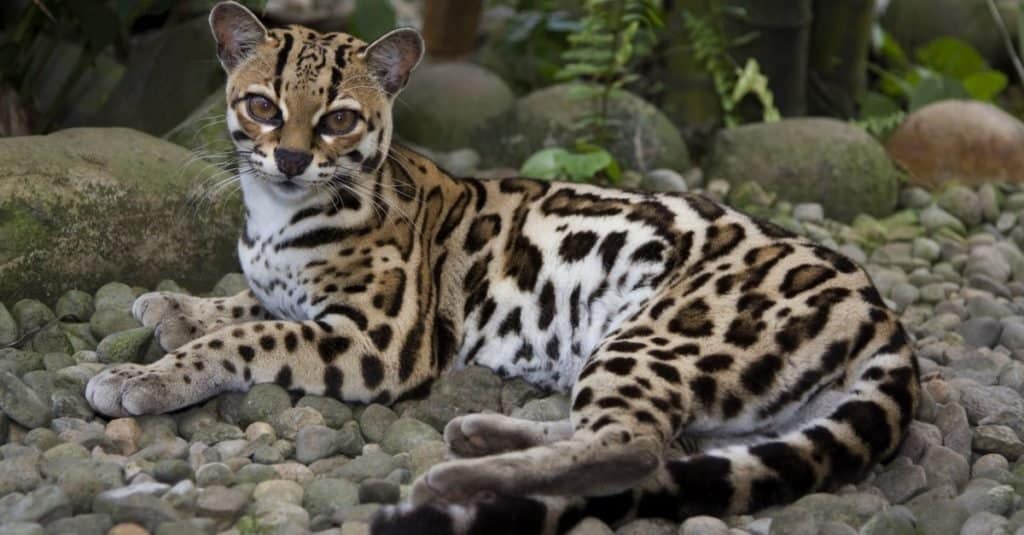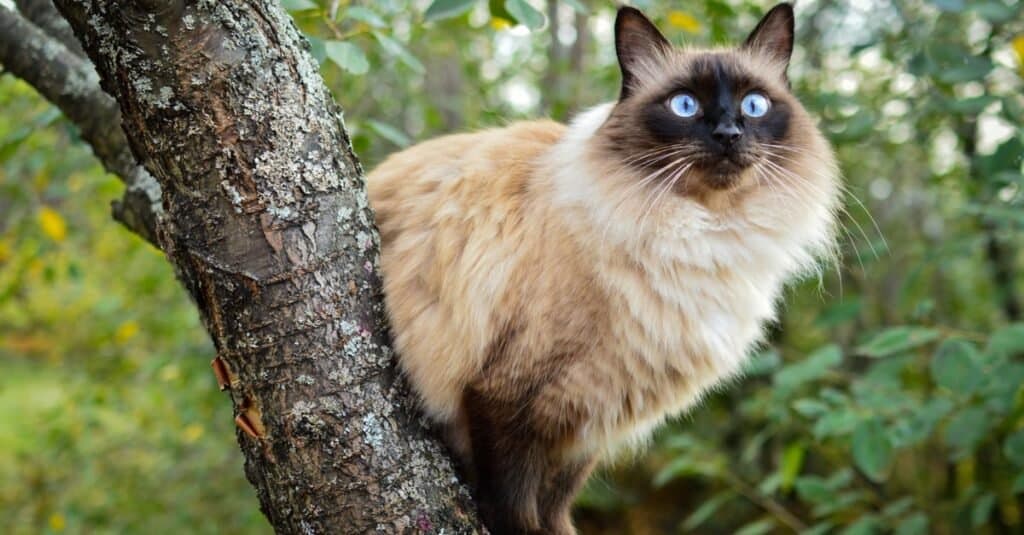Did you know you share 98.8% of your DNA with chimps? Similarly, domestic cats share 95.6% of their DNA with tigers. These sweet floofs that grace millions of homes throughout the world have a lot in common with the biggest cats of all. Like wildcats, house cats engage their hunting skills (even if their “mice” are filled with catnip) and rest for long periods, as if preparing to hunt. They still climb at will, sometimes making it to the tops of trees — but have you ever wondered why they get stuck? Can cats climb down when they’ve made it so high up? Let’s find out!
Species Profile: Cats

Although they’ve developed a reputation for their smug attitudes, cats are also quite cuddly and sweet, bonding with their owners.
©evrymmnt/Shutterstock.com
Cats hold a special place in people’s hearts throughout the world. Egyptians revered them as sacred, catering to them with jewels and treats. Currently, they fill social media feeds with their endearing faces and humorous antics. Although they’ve developed a reputation for their smug attitudes and rowdy responses to unwelcome stimuli, they are also quite cuddly and sweet, bonding with their owners.
Cats are also known for their sleepy natures, peacefully resting through 70% of their entire lives (13 – 16 hours every day!). Tiny cats, like Singapuras, are only about half the size of your regular domesticated cats. And then there are huge cats like Maine Coons, which can grow to just over 48 inches long! Several mixes lie in between, including ragdolls (known for their gentle natures), sphynx (known for their hairless bodies), and Siamese (known for their sociable personalities).
Where Do Cats Live?
Domestic cats can be found everywhere throughout the world except for the continent of Antarctica. They tend to be found alongside their human counterparts, whether living inside their homes or roaming through their neighborhoods. Even feral cats that have adapted to street life gravitate toward human environments, where there are plenty of food sources to sustain them. Sadly, their lives are much shorter and difficult without human care, and they often succumb to illnesses and diseases that are usually preventable.
House cats kept as indoor-only pets live the longest, most comfortable lives. These cats revel in quite the luxurious lifestyle, happily snoozing most of the day, waking just in time for meals and affection, using their own private restroom quarters, and never having to worry about predators. Depending on the breed, the cat’s past, and its individual personality, the kitty may be a cuddle-bug or may prefer to spend time on its own, perched on a cat tree.
How Many Kinds of Cats Are There?

The Devon rex is a popular cat breed.
©iStock.com/insonnia
There are many different types of cats. A few popular cat breeds include:
- British Shorthair
- Persian
- American Shorthair
- Abyssinian
- Exotic Shorthair
- Scottish Fold
- Burmese
- Russian Blue
- Siamese
- American Bobtail
- Oriental Shorthair
- Balinese
- Devon Rex
- Chartreux
- Turkish Angora
- Egyptian Mau
- Somali
- Manx
Although there are many domesticated cat breeds, there are also some wild (and bigger) cats worth mentioning. Those include:

Though many people are familiar with big cats like lions and tigers, some have never heard of the lesser-known margay, a beautiful exotic kitty.
©Jeff Grabert/Shutterstock.com
What Do Cats Eat?
Cats are carnivores, happily devouring meaty foods. Their bodies require protein to ensure their optimal health, including good vision and a strong heart. Many house cats eat canned wet food, kibble, and treats. However, some cats are fed a variety of homemade foods, including chicken and rice, tuna and salmon, oatmeal, and sweet potato. Some cats eat raw foods, including egg yolks, chicken thighs, chicken liver, chicken heart, rabbit carcass, raw beef kidney, and raw pork. Feral cats get creative when they’re out hunting, taking down birds, fish, and rodents but also taking the opportunity whenever possible to check out human garbage, pet food that’s been left out, and even roadkill on some occasions.
Are Cats Able to Climb Trees?
Cats have claws that allow them to grip trees easily and climb up. This process is a breeze for them. The reasons they climb trees vary. Cats are both predator and prey, so they may excitedly chase prey up a tree, or they may fearfully find themselves up a tree when trying to get away from a larger predator. Although these are two primary reasons, they’re not the only ones. Climbing may just be a fun activity for them!
Can Cats Climb Down from Trees?

Their claws are hooked, which helps on the way up but the only realistic way for them to get back down on their own is to go in reverse.
©Fazlyeva Kamilla/Shutterstock.com
Although cats are adept climbers, they may not always be able to get back down with the grace they displayed when climbing up. Usually, on the way down, they just take a leap back to the ground floor. However, if they get too high, they might find themselves in a precarious situation. If they don’t feel confident about the jump down, they may get stuck. Their claws are hooked, which helps on the way up. However, the only realistic way for them to get back down on their own is to go in reverse. In some cases, cats won’t do this. They can’t climb down with their heads first either. So, the answer is: It depends on the cat. But no, cats can’t usually climb down trees. They need your help if they venture too high up.
The photo featured at the top of this post is © Daniel_Ferryanto/Shutterstock.com
Thank you for reading! Have some feedback for us? Contact the AZ Animals editorial team.






